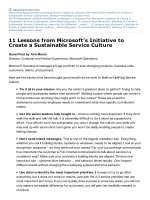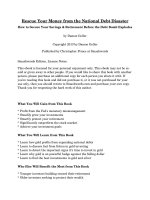Organise Your Paperwork: From Paper Mess to Paperless
Bạn đang xem bản rút gọn của tài liệu. Xem và tải ngay bản đầy đủ của tài liệu tại đây (1.99 MB, 159 trang )
Organise Your
Paperwork: From
paper Mess to
Paperless
Table of Contents
About the authors
Introduction
1 The cost of paper chaos
What is your paper chaos costing you?
Financial costs
Time costs
Emotional costs
Professional and social costs
Personal costs
Now calculate the true cost of your
paper jam
Time for forgiveness
From now on
How life could be
2 Harness your incoming paper in seconds
The incoming paper station
Step 1: Choose a location
Step 2: Choose an in-tray container
Step 3: Gather your daily tools
Step 4: Set some in-tray ground rules
eFlow
Stopping the inflow
Cruise control
Further downstream
3 Staying on top of routine paperwork
The recurring action station
Step 1: Decide what you need
Step 2: Choose a container and a
location
Step 3: Name your files
Step 4: Put it in your diary
Step 5: Create your labels
Step 6: Bring it all together
Rules for managing your recurring actions
Synchronising recurring actions on email
The ‘Out Bag’
Cruise control
Further downstream
4 Power through your projects
Identifying your key projects
Setting up the project file
Creating project flow — moving the project
along
Project paperwork comes in through
your in-tray
Schedule times and key actions into your
diary
Set a limit on the number of projects you
undertake at any one time
Keep the end in sight
Tell others about your project and its
completion date
Work with others
Mission accomplished
What about all those great ideas?
Cruise control
Further downstream
5 Find it when you need it
Why do you keep reference paper?
Common reference categories
Power sorting and big fat categories
Set your limits
Pick a date
Pick a number
Pick a container
Choosing your reference file containers
Filing cabinets
Lever arch folders
Magazine boxes
Display books
Storage boxes of varying shapes and
sizes
Setting up your reference files
Ready-reference information
Important documents
Banking and finance
Utilities or household expenses
Health
Children’s information
Tax
Warranties and manuals
Small receipts
Contacts
Online versus offline — keeping it simple
Cruise control
Further downstream
of John Wiley & Sons Australia, Ltd 42
McDougall St, Milton Qld 4064
Office also in Melbourne
Typeset in ITC Berkeley Oldstyle Std Book
11/13.5 pt
Organise Your Paperwork © MaryAnne Bennie
and Brigitte Hinneberg 2013
Excerpts taken from Paper Flow, first published in
2011 by Wrightbooks, an imprint of John Wiley &
Sons Australia, Ltd
The moral rights of the authors have been asserted
National Library of Australia Cataloguing-in-
Publication data:
Author: Bennie, MaryAnne.
Title: Organise your paperwork: from paper mess
to paperless / MaryAnne Bennie and Brigitte
Hinneberg.
ISBN: 9781118626542 (pbk.)
Subjects: Paperwork (Office practice) —
Management. Filing systems. Time management.
Life skills.
Other Authors/ Contributors: Hinneberg, Brigitte,
1970-
Dewey Number: 651.5
All rights reserved. Except as permitted under the
Australian Copyright Act 1968 (for example, a
fair dealing for the purposes of study, research,
criticism or review), no part of this book may be
reproduced, stored in a retrieval system,
communicated or transmitted in any form or by any
means without prior written permission. All
inquiries should be made to the publisher at the
address above.
Cover design by Susan Olinsky
Cover image: © iStockphoto.com / milalala
Internal design by Peter Reardon,
www.pipelinedesign.com.au
Printed in China by Printplus Limited
10 9 8 7 6 5 4 3 2 1
Disclaimer
The material in this publication is of the nature of
general comment only, and does not represent
professional advice. It is not intended to provide
specific guidance for particular circumstances and
it should not be relied on as the basis for any
decision to take action or not take action on any
matter which it covers. Readers should obtain
professional advice where appropriate, before
making any such decision. To the maximum extent
permitted by law, the authors and publisher
disclaim all responsibility and liability to any
person, arising directly or indirectly from any
person taking or not taking action based on the
information in this publication.
MaryAnne Bennie is an organising expert,
speaker and director of in8 home office and life
organising. As a busy working woman, with a
husband, three adult children and four
grandchildren, MaryAnne understands the struggle
of the juggle of home, office and life. In 2002 she
created the Paper Flow system and has since
introduced thousands of people to the system
through numerous workshops and private
consultations. She is a former university lecturer
and holds a Bachelor of Education and a Master of
Business. In order for this book to come alive,
MaryAnne joined forces with author Brigitte
Hinneberg and this book is the result of their
combined strengths.
Brigitte Hinneberg is an author, presenter and
business coach with a passion for helping busy
people achieve work-life balance by encouraging
order. Brigitte’s first book, Did You Remember
The Milk?, is the essential home organiser for very
busy people. Brigitte is a certified lifestyle coach
with a degree in Economics and Commerce. After
a successful 12 year marketing career, Brigitte
founded Momentum Coaching and Consulting, a
coaching practice helping executives and private
individuals save time, money and stress. Brigitte
lives in Brisbane, Australia with her husband and
three children who provide plenty of inspiration
for her books and organisational resources.
Paper flows through our lives. It maps our
journeys, showing where and when we were born,
our progress through school, where we travel and
where we choose to call home. Paper celebrates
our life achievements through school reports,
diplomas, degrees and work contracts. We
accumulate permission documents such as
licences, accreditations and endorsements.
Marriage and birth certificates are evidence that
we loved and we left living legacies. Invoices,
account summaries and receipts show what we
exchanged our hard-earned money for, be it
electricity, lounge suites, houses or holidays.
We begin life with a single piece of paper — the
birth certificate is the wellspring — and we gather
more and more simply by living. At times the
paper flows like a torrent, and just like any river, it
is a great servant but a poor master. When the river
bank breaks and paper floods our lives, all we can
do is try to keep our heads above it all and hope
that we don’t get snagged by a lost tax receipt,
misplaced warranty or unpaid insurance reminder.
This can put enormous stress on relationships, as
well as create serious consequences downstream.
Every person is unique, in their lifestyle, personal
history, needs and goals for the future. In this book,
we use the Paper Flow strategy to demonstrate
how to create a simple, personalised system for
managing the paper that flows into your home and
office. We will show you how to make sure your
paper buoys, rather than drowns you.
You can start to save yourself from the paper
deluge by acknowledging some truths about paper:
1 Paper needs to earn the right to take up your
space.
Paper will fill the space made available for it.
We have an infinite capacity to bring paper into
our lives, but we have a finite space in which to
store it. Consider your storage space when
deciding what to keep. Everything in your home
and office is competing for precious space, so
make sure your paperwork is earning its right to
be there.
2 Look after the 20 per cent.
Most paper is unnecessary. Only 20 per cent of
the paper we keep is ever actually referred to
again. A whopping 80 per cent of it is never
going to be looked at again, ever! Look after the
20 per cent you need and release the rest.
3 It’s always urgent when you can’t find it.
When paper is needed, it’s needed now! You
never know when you’re going to need that
important document, but when you do, it’s almost
always in a hurry. These unexpected deadlines
send you into a spin as you madly search through
your paper jungle. The person who can quickly
and easily find that document when they need it,
wins.
4 Paper likes to be with its friends.
Your paper wants to be with paper just like it. It
wants to be with similar types of information and
with similar shapes and sizes. When the
important documents are mixed in with the
‘sentimental’, and the ‘sentimental’ is mingling
too closely with the ‘nice to read but not really
necessary to keep’, you get paper friction. When
large receipts are mixed together with small
dockets, neither is happy with the other’s storage
solution because of their different shapes and
sizes. When paper is disorganised, you feel
disorganised too. It’s contagious.
5 Your paper will tell you how it wants to be
stored.
It really is that simple. Many people get
sidetracked by frustrating questions, such as:
Does my home insurance information get a file of
its own, or should I file it under ‘House’? Do
management reports go under ‘Company
Reports’ or by subject file? The possibilities
seem endless. You just need to listen to your
paper, it will tell you what it needs.
6 Storage is a tool, not a solution.
Storage is not the answer to disorganised
paperwork. Storage containers, files, and
stationery are merely tools, and a tool without a
system is just clutter. People buy all sorts of
tools to contain their mess, only to have it add
further chaos as they shift the piles into
suspension files, then folders, then boxes and
back to suspension files. It’s like the outfit you
bought in a hurry that doesn’t quite fit; no matter
how hard you try, it’s not going to look or feel
good. Paper Flow creates the right system which
then determines your storage needs, not the other
way around.
7 Paper will evolve.
Your paperwork system will change and evolve,
just like you. A good system will adapt, expand
and contract as your needs and lifestyle change.
A good paperwork system preserves your past,
documents your present and anticipates your
future.
8 Paper needs to flow.
As it flows in, through and out of your home and
office it needs a home at each stage of its
journey. When paper doesn’t flow, we
experience ‘office constipation’. When paper is
allowed to flow and is in the right place at the
right time you relax and feel supported. You are
able to concentrate on the ‘here and now’,
knowing that your paperwork is sorted,
organised and filed.
These eight truths form the basis of the Paper Flow
philosophy. Paper Flow is a fail-safe, tried and
tested approach to paper management that will
support you in the real world, through all the ebbs
and flows of life.
This book provides step-by-step instructions on
how to move paper in, through and out of your
home and office. It will take about a week to get it
up and running, and then it will take you around ten
minutes a day to keep your day-to-day paperwork
in check.
Keep a notebook handy as you work through the
book so you can jot down any ‘to dos’, key
decisions and any items you need to buy.
Case studies in each chapter offer you real life
examples of Paper Flow problems and solutions as
experienced by a wide variety of people in
different situations.
Tips for success highlight for you some of the key
ideas and concepts that will give you the real
Paper Flow edge.
Decide now prompters will ask you to pause for a
moment and make a decision. If you’re not sure,
rather than skipping ahead, just trust your
judgement at that point in time and make a choice
so you can move on to the next step of the Paper
Flow system. Once your system is up and running
you can always go back and make adjustments.
Paper Flow will turn your paperwork into what
you want it to be — your friend and support. You
will be able to find anything you need when you
need it. You will be able to easily and confidently
handle all the paperwork that comes your way.
And you will know exactly where to put each
piece of paper without a moment of hesitation or
doubt. Waste no more time, money, energy and
space! Read on for a solution that streams your
Paper Flow into a logical, low-maintenance,
sustainable system.
Maybe someone gave you this copy of Organise
Your Paperwork because they thought you could
do with a few hints? Or perhaps you happened
upon it, deciding once and for all that Organise
Your Paperwork would finally put an end to your
paper chaos? Or you may be a person who already
has an organised paper system but is looking for a
few extra tips and ideas. Regardless of your
starting position, taking stock of the cost of paper
chaos will show you the true value of creating
Paper Flow in your home or office.
Many people are surprised to learn just how much
their paper chaos is costing them. The true cost of
the paper jam in our lives is enormous: we lose
sleep worrying about where we put things; we
spend ridiculous amounts on fines, interest and late
fees, as well as repeat purchases for items we
can’t find; we decline invitations from friends; and
we spend too much time looking for important
documents. We are never in the moment — we
arrive late and leave early. Our ‘busyness’ creates
a barrier between us and the world, and we can
never seem to just relax.
People often tell us they feel like a fraud when
they’re disorganised, that their public persona is
concealing their private chaos. It’s like the duck
that always looks calm on the surface, but is
paddling like mad underneath to stay afloat. Our
confidence is eroded and we start worrying about
what our friends and colleagues would think if they
knew the state we were in. No wonder we wake up
in the middle of the night and feel like screaming
‘Enough!’









